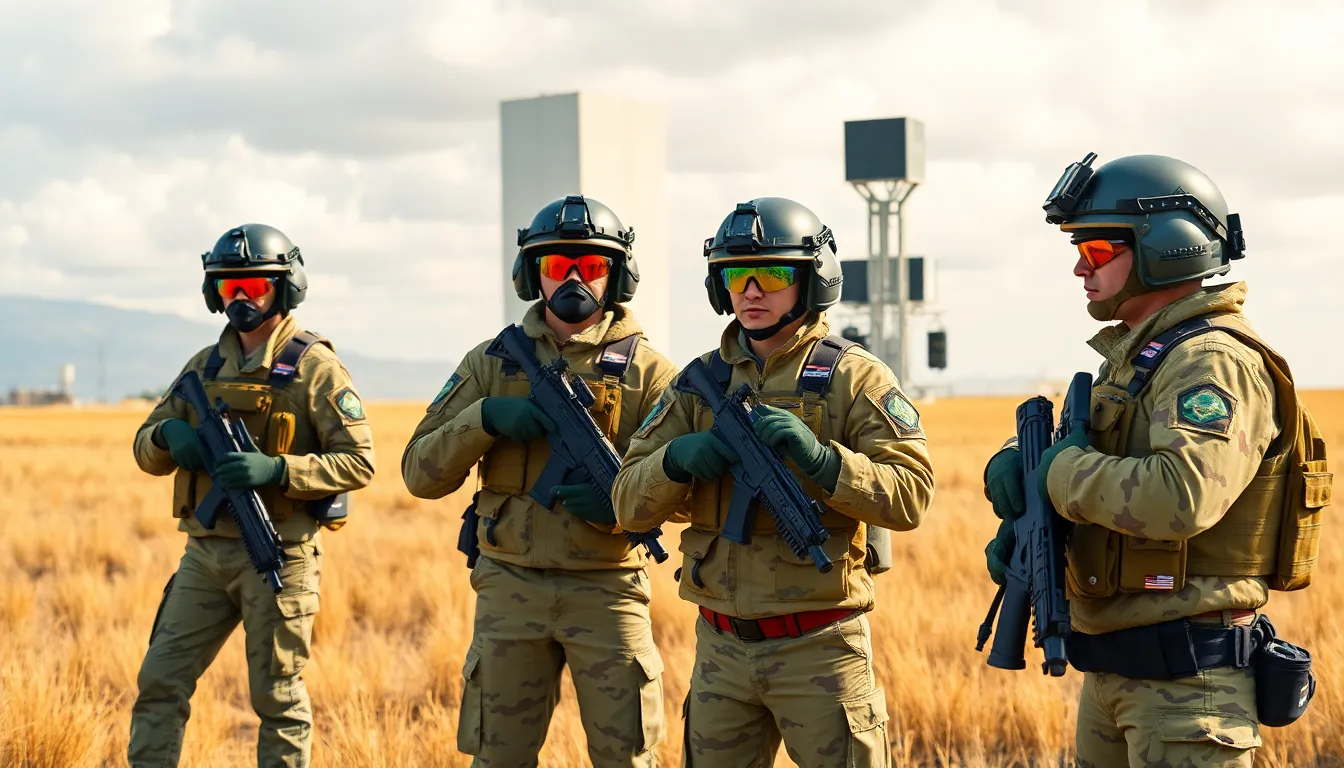In a world where domestic nuclear detection might sound like a plot twist from a sci-fi movie, it’s actually a crucial aspect of national security. Imagine a team of highly trained professionals, equipped with cutting-edge technology, working tirelessly to keep homes safe from nuclear threats. It’s like having a superhero squad, but instead of capes, they wear lab coats and carry radiation detectors.
DomesticNuclearDetectionOffice
Domestic Nuclear Detection Office (DNDO) focuses on enhancing nuclear detection capabilities within the United States. Established as part of the Department of Homeland Security, DNDO coordinates efforts to prevent illicit nuclear or radiological materials from entering the country.
Advanced technologies are a key component of DNDO’s operations. They deploy sophisticated tools that include radiation detection systems and scientific analysis methods to monitor potential threats effectively. Professionals within this office undergo specialized training to interpret data accurately and respond to incidents.
Collaboration is crucial for DNDO’s success. Partnerships with local, state, and federal agencies ensure a comprehensive approach to nuclear detection. They work alongside law enforcement and intelligence agencies to share vital information, enhancing overall security measures.
National security relies heavily on ongoing research and development in detection technologies. DNDO invests in innovative solutions that improve detection rates and decrease false alarms. Continuous improvement drives their strategies to adapt to evolving threats.
Public outreach plays a significant role in DNDO’s mission. Educating communities about nuclear safety helps promote awareness and preparedness against potential threats. By providing resources and guidance, they empower individuals to contribute to national security.
Overall, DNDO’s commitment to safeguarding the nation against nuclear risks remains unwavering. They utilize advanced technology, foster collaboration, and engage with the public to create a safer environment.
Mission and Objectives

The Domestic Nuclear Detection Office (DNDO) focuses on enhancing national security through effective nuclear threat detection. Their mission emphasizes the protection of the United States from illicit nuclear and radiological materials.
Core Functions
Detection technology development stands as a primary function of the DNDO. They invest in advanced tools that enhance radiation detection capabilities. Training programs equip professionals with necessary skills for monitoring potential nuclear threats. Information sharing with local, state, and federal agencies fosters collaboration against nuclear risks. By coordinating nationwide efforts, DNDO strengthens overall security and detection efficiency.
Strategic Goals
The strategic goals of the DNDO center on improving detection rates and minimizing false alarms. Enhancing research and development initiatives emerges as a priority in their mission. Building partnerships with law enforcement and intelligence agencies aids in comprehensive threat assessment. Educating the public about nuclear safety remains crucial, as community awareness contributes to preparedness. Prioritizing innovation and collaboration allows DNDO to maintain its commitment to safeguarding the nation against nuclear dangers.
Technologies and Innovations
Domestic nuclear detection relies on cutting-edge technologies and continuous innovation. The focus remains on enhancing detection capabilities and safeguarding communities.
Detection Methods
Advanced detection methods include radiation portal monitors and handheld spectrometers. Both tools play a critical role in identifying radioactive materials at borders and within populated areas. Radiation portal monitors scan vehicles and cargo containers, ensuring immediate alerts if threat materials are detected. Handheld spectrometers allow trained professionals to analyze suspected items directly, offering flexibility and precision on the ground. Together, these methods form an integrated approach to nuclear detection.
Research and Development
Ongoing research and development drive the evolution of detection technologies. The Domestic Nuclear Detection Office invests in projects aimed at improving equipment sensitivity and accuracy. Innovative algorithms analyze data from multiple sources, significantly reducing false alarms. Collaboration with universities and private sectors accelerates the pace of advancements, fostering breakthroughs in detection methods. Growing partnerships enhance capabilities, ensuring the nation remains prepared against potential nuclear threats.
Partnerships and Collaborations
Effective partnerships and collaborations underpin the success of the Domestic Nuclear Detection Office (DNDO) in enhancing national security. These alliances strengthen the country’s ability to address nuclear threats through shared resources and expertise.
Government Partnerships
Government partnerships play a pivotal role in the efforts of DNDO. Collaborating with local, state, and federal agencies enables seamless communication. Key agencies include the Department of Energy and the Federal Bureau of Investigation. Each entity contributes unique capabilities that bolster nuclear detection and prevention strategies. Information sharing among these organizations ensures rapid response to potential threats. Joint training exercises and workshops enhance skill development for first responders. Such collaborations solidify a robust national defense against nuclear and radiological materials.
International Cooperation
International cooperation broadens the scope of DNDO’s effectiveness. Working with foreign governments and international organizations fosters a global approach to nuclear detection. Agreements with agencies like the International Atomic Energy Agency establish standardized protocols across borders. These partnerships facilitate intelligence sharing, improving the detection of illicit materials worldwide. By participating in joint initiatives, the United States strengthens its global commitment to nuclear safety. Each cooperative venture enhances preparedness and promotes shared best practices in nuclear threat mitigation.
Impact and Effectiveness
Domestic nuclear detection plays a crucial role in national security. The Domestic Nuclear Detection Office (DNDO) effectively prevents the entry of illicit nuclear materials into the United States. Professionals within the DNDO deploy advanced technology to monitor and identify potential threats. Their collaboration with local, state, and federal agencies ensures comprehensive threat assessments arise from shared information.

Advanced detection methods contribute significantly to their effectiveness. Radiation portal monitors and handheld spectrometers serve as essential tools in identifying radioactive materials. Ongoing research and development efforts enhance equipment sensitivity and accuracy. Innovative algorithms create improved data analysis capabilities, ultimately reducing false alarms.
Additionally, partnerships amplify the impact of nuclear detection efforts. Collaborations with agencies such as the Department of Energy and the Federal Bureau of Investigation streamline communication and response times. Training exercises conducted jointly foster readiness among response teams. Global cooperation with organizations like the International Atomic Energy Agency further strengthens the DNDO’s initiatives. Such cooperation broadens the approach to nuclear detection.
Education and community engagement highlight the effectiveness of public awareness campaigns. Informing the public about nuclear safety promotes preparedness at every level. Ultimately, the focus on innovation, collaboration, and communication underscores DNDO’s commitment to safeguarding the nation from nuclear threats. The continuous advancement of detection technology exemplifies a proactive stance against potential risks in an evolving security landscape.
Challenges and Limitations
Domestic nuclear detection faces several significant challenges and limitations. Equipment sensitivity varies greatly, which can lead to inconsistent detection rates. False alarms create frustration among operators and can reduce trust in detection systems. These discrepancies often stem from environmental factors such as background radiation, complicating accurate assessments.
Detection technology requires continuous improvement to keep pace with evolving threats. Cybersecurity vulnerabilities pose a growing risk, as advanced technologies may be susceptible to hacking. As the capabilities increase, so do the tactics of illicit actors, making countermeasures essential.
Funding constraints limit the scale of research and development projects. Officials must prioritize investments in high-impact areas, which can leave other critical initiatives underfunded. The constantly changing threat landscape necessitates agility, yet budgetary restrictions hinder response capabilities.
Training and coordination among various agencies represent another challenge. Effective communication remains key to a united response. Interagency collaboration often faces obstacles, such as differing priorities and operational procedures, which can slow down decision-making processes.
Public engagement serves as an essential aspect of nuclear safety, yet raising awareness poses difficulties. Misunderstandings can lead to apathy or undue fear within communities. Educational campaigns require sensitive messaging to effectively convey the importance of nuclear readiness, while also encouraging public involvement.
Finally, international collaboration adds complexity. Cultural differences and varying regulatory frameworks can impede cooperation. While partnerships with global entities strengthen capabilities, they also introduce challenges in standardization and policy alignment.


